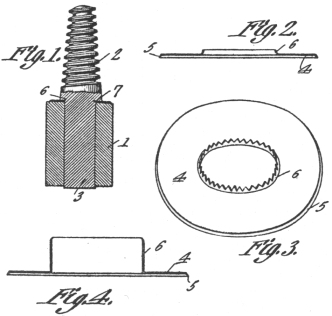Cross-Arm and Pin Protector
Reprinted from "INSULATORS - Crown Jewels of the Wire", January 1984, page 28
Mr. & Mrs. Jack Snyder sent us the
following article from the 1913 Telephone Engineer magazine.
Cross-Arm and Pin
Protector
Indirect losses from line troubles and direct losses through repair
expense on decayed pins and crossarms, amount to a considerable item. Telephone
men, therefore, will be interested in a cross-arm and pin protector recently
devised and patented by Henry G. Newell of the People's Consolidated Telephone
Company, Rome, Pa. The invention is a device for preventing water from entering
into the joint between the cross arm of a telegraph pole and the pins which are
mounted thereon. By thus preventing moisture from getting into the said joints
it is found that the life of these members is greatly increased.
Fig. 1 is a
cross sectional view of a cross arm and pin, with the improved protector
attached. Fig. 2 is a side view of the protector. Fig, 3 is a perspective view
of the same. Fig. 4 is a slightly modified form of the protector.
In the
drawing, 1 is a wooden cross arm such as is commonly used on telegraph and
telephone poles, a wooden pin 2 being shown connected thereto and having the
usually lowered portion 3 extending down into a hole in the cross arm, all of
which is of the usual form and construction.
The protector as shown in Fig. 1,
is placed between the shoulder of pin 7 and the upper surface of the cross arm
and consists of a flat thin body portion 4, around the outer edge of which is
the downwardly extending flange 5, said flange terminating in a knife-like or
saw-tooth edge so that the flange may be readily driven into the wooden cross arm
as shown in Fig. 1. The body portion 4 is provided at its inner edge with an
annular upturned flange 6 which flange has at its extremity a knife-like edge
which may also be serrated as shown in Fig. 3. By thus constructing the flange
6, it is readily driven into the wooden pin 2.
A somewhat modified form of
protector is shown in Fig. 4, in which the flange 6 is somewhat elongated and is
adapted to fit over the pin 2. Its extreme edge is adapted to be bent against
and driven into the pin.

Details of Cross Arm and Pin Protector
By the use of this protector, water and moisture is
prevented from entering between the pin and cross arm, thereby preventing the
premature decay of both pin and cross arm and lengthening the life of each at
its most vulnerable point.
| 